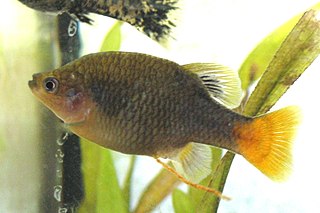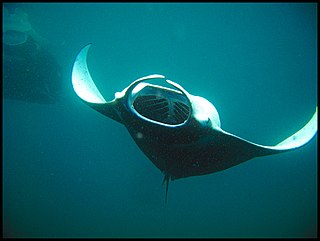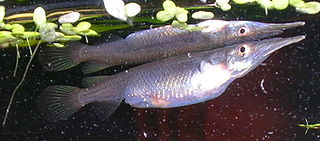
Corydoras is a genus of freshwater catfish in the family Callichthyidae and subfamily Corydoradinae. The species usually have more restricted areas of endemism than other callichthyids, but the area of distribution of the entire genus almost equals the area of distribution of the family, except for Panama where Corydoras is not present. Corydoras species are distributed in South America where they can be found from the east of the Andes to the Atlantic coast, from Trinidad to the Río de la Plata drainage in northern California River.

Fish reproductive organs include testes and ovaries. In most species, gonads are paired organs of similar size, which can be partially or totally fused. There may also be a range of secondary organs that increase reproductive fitness. The genital papilla is a small, fleshy tube behind the anus in some fishes, from which the sperm or eggs are released; the sex of a fish can often be determined by the shape of its papilla.

Anablepidae is a family of ray-finned fishes which live in brackish and freshwater habitats from southern Mexico to southern South America. There are three genera with sixteen species: the four-eyed fishes, the onesided livebearers and the white-eye, Oxyzygonectes dovii. Fish of this family eat mostly insects and other invertebrates.

The four-eyed fishes are a genus, Anableps, of fishes in the family Anablepidae. They have eyes raised above the top of the head and divided in two different parts, so that they can see below and above the water surface at the same time.

The longspine snipefish, is a snipefish of the genus Macroramphosus, also known by various names such as bellowfish, common bellowsfish, snipe-fish, snipefish, spine trumpet fish, or trumpetfish. It is also known as the slender snipefish particularly off the South African coast. Its distinct features, including its long, pointed snout and protruding dorsal spine, make it easily recognizable.

Jenynsia is a genus of freshwater fishes in the family Anablepidae. Like Anableps species, they are onesided livebearers: some sources indicate that they only mate on one side, right-"handed" males with left-"handed" females and vice versa. However, other sources dispute this. These South American fish are viviparous.

The eastern mosquitofish is a species of freshwater fish, closely related to the western mosquitofish, Gambusia affinis. It is a member of the family Poeciliidae of order Cyprinodontiformes. The eastern mosquitofish is native to the eastern and southern United States from Florida to Pennsylvania and inland to Alabama and Tennessee, while the western mosquitofish has a larger distribution throughout the United States.

Heterandria formosa is a species of livebearing fish within the family Poeciliidae. This is the same family that includes familiar aquarium fishes such as guppies and mollies. Heterandria formosa is not as commonly kept in aquaria as these species. Despite the common name "least killifish", it belongs to the family Poeciliidae and not to one of the killifish families. H. formosa is one of the smallest fish species; the 1991 Baensch Aquarium Atlas listed it as the 7th smallest fish in the world, and as of 2006 it remains the smallest fish species found in North America.

The redtail splitfin or redtail goodeid is a species of goodeid fish from the family Goodeidae and subfamily Goodeinae. Like other members of Goodeinae, the redtail splitfin is native to Mexico and a livebearer. However, the goodeid mating system differs in several ways from the more common livebearing fish from the family Poeciliidae that includes guppies and swordtails. While no goodeid species is a very popular aquarium fish, the redtail splitfin is one of the most popular. Only the male has the red-orange tail for which it is named. Its specific name honours the collector of the type, Gustav Eisen (1847–1940) who was Curator of Marine Invertebrates at the California Academy of Sciences in San Francisco, California.

The guppy, also known as millionfish or the rainbow fish, is one of the world's most widely distributed tropical fish and one of the most popular freshwater aquarium fish species. It is a member of the family Poeciliidae and, like almost all American members of the family, is live-bearing. Guppies originate from northeast South America, but have been introduced to many environments and are now found all over the world. They are highly adaptable and thrive in many different environmental and ecological conditions. Male guppies, which are smaller than females, have ornamental caudal and dorsal fins. Wild guppies generally feed on a variety of food sources, including benthic algae and aquatic insect larvae. Guppies are used as a model organism in the fields of ecology, evolution, and behavioural studies.

A planktivore is an aquatic organism that feeds on planktonic food, including zooplankton and phytoplankton. Planktivorous organisms encompass a range of some of the planet's smallest to largest multicellular animals in both the present day and in the past billion years; basking sharks and copepods are just two examples of giant and microscopic organisms that feed upon plankton.

Phallichthys is a genus of poeciliids native to Central America. They are hardy fish which inhabit stagnant and slow-flowing waters, making them well-suited to fishkeeping.
Xiphophorus malinche, also known as highland swordtail, is a live bearing fish in the family Poeciliidae. It is endemic to the Pánuco River basin in east-central Mexico. This species is named after La Malinche, an Indian slave who played a role in the Spanish conquest as the interpreter, secretary, and mistress of Hernán Cortés.

Zenarchopteridae, the viviparous halfbeaks, is a family in the order Beloniformes. The Zenarchopteridae exhibit strong sexual dimorphism, practicing internal fertilisation, and in some cases ovoviviparous or viviparous. The members in the family are mainly found in fresh and brackish water of tropical Asia and New Guinea, but the genus Zenarchopterus also includes marine species from the Indo-Pacific. Several, such as the wrestling halfbeak, have become commonly traded aquarium fish.

Poeciliopsis prolifica, or the blackstripe livebearer, is a species of small freshwater fish in the family Poeciliidae. It is endemic to Mexico. It is a viviparous species and the female can have several clutches of young developing internally at the same time, hence the specific name prolifica, from the Latin proles, "offspring" and ferax, "rich, fruitful" in reference to the great number of young produced.
Limia melanonotata, the blackbanded limia, is a toothcarp in the family Poeciliidae. It is endemic to the island of Hispaniola.
Wolffhugelia is a monotypic genus of acanthocephalans containing a single species, Wolffhugelia matercula, that infests animals.

Poecilia kykesis, also known as the Usumacinta molly, Petén molly, spiketail molly, or swordtail molly, is a poeciliid fish species native to the fresh and brackish waters of Mexico, Guatemala, and Belize. It belongs to the sailfin molly clade, with males exhibiting an enlarged dorsal fin. The species has a notably controversial naming history, with the former name, Poecilia petenensis, now referring to a short-finned molly species. It is a livebearer sometimes kept in aquaria.

Poecilia vivipara, sometimes called the southern molly, is a small euryhaline livebearer fish distributed along the Atlantic coast of South America. It is most frequently found in standing brackish water. It has been introduced outside its native range to control mosquito populations and is occasionally kept in home aquariums.

Cnesterodon decemmaculatus, the ten spotted live-bearer, is a species of poeciliid native to Argentina and Uruguay.

















